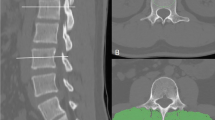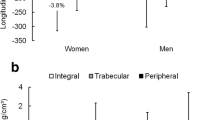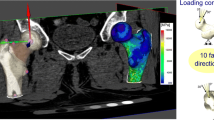Abstract
Introduction
The aim of this study was to investigate the association between handgrip strength (HGS) and the risk of subsequent vertebral fracture (SVF) after percutaneous vertebral augmentation (PVA).
Materials and methods
A total of 340 patients aged over 50 years with osteoporotic vertebral fracture were enrolled in this 3-year follow-up investigation. HGS was measured with a hand-held dynamometer before PVA. Female patients and male patients were grouped using the HGS threshold recommended by the Asian Working Group for Sarcopenia (AWGS). Kaplan–Meier analysis was used to evaluate SVF-free survival. The hazard ratios (HRs) of HGS for SVF events were estimated with the Cox proportional hazards model.
Results
During the follow-up period, a total of 93 patients (27.4%) experienced SVF. Kaplan–Meier analysis showed that the HGS of female patients < 18.0 kg and male patients < 28 kg was significantly associated with lower SVF-free survival (female patients: p < 0.001, male patients: p = 0.038; log-rank test). Among women, each 1-kg increase in HGS was associated with a 9% lower risk of SVF (HR 0.91, p = 0.035) after adjustment for potential risk factors. Among men, although the associations between low HGS and increased risk of SVF were significant in the crude model (HR 0.79, p < 0.001), this significance disappeared after adjustment for bone mineral density of the femoral neck.
Conclusions
Low HGS was significantly associated with lower SVF-free survival among elderly patients who underwent single-level PVA for osteoporotic vertebral fracture.

Similar content being viewed by others
References
Zeytinoglu M, Jain RK, Vokes TJ (2017) Vertebral fracture assessment: enhancing the diagnosis, prevention, and treatment of osteoporosis. Bone 104:54–65. https://doi.org/10.1016/j.bone.2017.03.004
Goldstein CL, Chutkan NB, Choma TJ, Orr RD (2015) Management of the elderly with vertebral compression fractures. Neurosurgery 77:S33–45. https://doi.org/10.1227/neu.0000000000000947
Kim MH, Lee AS, Min SH, Yoon SH (2011) Risk factors of new compression fractures in adjacent vertebrae after percutaneous vertebroplasty. Asian Spine J 5:180–187. https://doi.org/10.4184/asj.2011.5.3.180
Li YA, Lin CL, Chang MC, Liu CL, Chen TH, Lai SC (2012) Subsequent vertebral fracture after vertebroplasty: incidence and analysis of risk factors. Spine 37:179–183. https://doi.org/10.1097/BRS.0b013e3181f72b05
Lee BG, Choi JH, Kim DY, Choi WR, Lee SG, Kang CN (2019) Risk factors for newly developed osteoporotic vertebral compression fractures following treatment for osteoporotic vertebral compression fractures. Spine J Off J N Am Spine Soc 19:301–305. https://doi.org/10.1016/j.spinee.2018.06.347
Yang CC, Chien JT, Tsai TY, Yeh KT, Lee RP, Wu WT (2018) Earlier vertebroplasty for osteoporotic thoracolumbar compression fracture may minimize the subsequent development of adjacent fractures: a retrospective study. Pain physician 21:E483–E491
Sui SX, Holloway-Kew KL, Hyde NK, Williams LJ, Tembo MC, Mohebbi M, Gojanovic M, Leach S, Pasco JA (2020) Handgrip strength and muscle quality in Australian women: cross-sectional data from the Geelong Osteoporosis Study. J Cachexia Sarcopenia Muscle. https://doi.org/10.1002/jcsm.12544
Sipilä S, Törmäkangas T, Sillanpää E, Aukee P, Kujala UM, Kovanen V, Laakkonen EK (2020) Muscle and bone mass in middle-aged women: role of menopausal status and physical activity. J Cachexia Sarcopenia Muscle. https://doi.org/10.1002/jcsm.12547.10.1002/jcsm.12547
Verschueren S, Gielen E, O'Neill TW, Pye SR, Adams JE, Ward KA, Wu FC, Szulc P, Laurent M, Claessens F, Vanderschueren D, Boonen S (2013) Sarcopenia and its relationship with bone mineral density in middle-aged and elderly European men. Osteoporos Int J Establ Result Coop Between Eur Found Osteoporos Natl Osteoporos Found USA 24:87–98. https://doi.org/10.1007/s00198-012-2057-z
Balogun S, Winzenberg T, Wills K, Scott D, Jones G, Aitken D, Callisaya ML (2017) Prospective associations of low muscle mass and function with 10-year falls risk, incident fracture and mortality in community-dwelling older adults. J Nutr Health Aging 21:843–848. https://doi.org/10.1007/s12603-016-0843-6
Wang WF, Lin CW, Xie CN, Liu HT, Zhu MY, Huang KL, Teng HL (2019) The association between sarcopenia and osteoporotic vertebral compression refractures. Osteoporos Int J Establ Result Coop Between Eur Found Osteoporos Natl Osteoporos Found USA 30:2459–2467. https://doi.org/10.1007/s00198-019-05144-x
Szulc P, Blaizot S, Boutroy S, Vilayphiou N, Boonen S, Chapurlat R (2013) Impaired bone microarchitecture at the distal radius in older men with low muscle mass and grip strength: the STRAMBO study. J Bone Miner Res Off J Am Soc Bone Miner Res 28:169–178. https://doi.org/10.1002/jbmr.1726
Kamiya K, Kajita E, Tachiki T, Ikehara S, Kouda K, Sato Y, Tamaki J, Kagamimori S, Iki M (2019) Association between hand-grip strength and site-specific risks of major osteoporotic fracture: results from the Japanese Population-based Osteoporosis Cohort Study. Maturitas 130:13–20. https://doi.org/10.1016/j.maturitas.2019.09.008
Cheung CL, Tan KC, Bow CH, Soong CS, Loong CH, Kung AW (2012) Low handgrip strength is a predictor of osteoporotic fractures: cross-sectional and prospective evidence from the Hong Kong Osteoporosis Study. Age (Dordrecht, Netherlands) 34:1239–1248. https://doi.org/10.1007/s11357-011-9297-2
Center JR, Bliuc D, Nguyen TV, Eisman JA (2007) Risk of subsequent fracture after low-trauma fracture in men and women. JAMA 297:387–394. https://doi.org/10.1001/jama.297.4.387
Ma X, Xia H, Wang J, Zhu X, Huang F, Lu L, He L (2019) Re-fracture and correlated risk factors in patients with osteoporotic vertebral fractures. J Bone Miner Metab 37:722–728. https://doi.org/10.1007/s00774-018-0974-4
Paik JM, Rosen HN, Katz JN, Rosner BA, Rimm EB, Gordon CM, Curhan GC (2019) BMI, waist circumference, and risk of incident vertebral fracture in women. Obesity (Silver Spring, Md) 27:1513–1519. https://doi.org/10.1002/oby.22555
Kanis JA, Johnell O, Oden A, Johansson H, De Laet C, Eisman JA, Fujiwara S, Kroger H, McCloskey EV, Mellstrom D, Melton LJ, Pols H, Reeve J, Silman A, Tenenhouse A (2005) Smoking and fracture risk: a meta-analysis. Osteoporos Int J Establ Result Coop Between Eur Found Osteoporos Natl Osteoporos Found USA 16:155–162. https://doi.org/10.1007/s00198-004-1640-3
Baroud G, Nemes J, Ferguson SJ, Steffen T (2003) Material changes in osteoporotic human cancellous bone following infiltration with acrylic bone cement for a vertebral cement augmentation. Comput Methods Biomech Biomed Eng 6:133–139. https://doi.org/10.1080/1025584031000095746
Imai K (2015) Analysis of vertebral bone strength, fracture pattern, and fracture location: a validation study using a computed tomography-based nonlinear finite element analysis. Aging Dis 6:180–187. https://doi.org/10.14336/ad.2014.0621
Rouzi AA, Ardawi MS, Qari MH, Bahksh TM, Raddadi RM, Ali AY, Jalal MM, Taha AA, Kary HS (2015) Risk factors for falls in a longitudinal cohort study of Saudi postmenopausal women: the Center of Excellence for Osteoporosis Research Study. Menopause (New York, NY) 22:1012–1020. https://doi.org/10.1097/gme.0000000000000418
Yu R, Leung J, Woo J (2014) Incremental predictive value of sarcopenia for incident fracture in an elderly Chinese cohort: results from the Osteoporotic Fractures in Men (MrOs) Study. J Am Med Dir Assoc 15:551–558. https://doi.org/10.1016/j.jamda.2014.02.005
Ignasiak D, Valenzuela W, Reyes M, Ferguson SJ (2018) The effect of muscle ageing and sarcopenia on spinal segmental loads. Eur Spine J Off Publ Eur Spine Soc Eur Spinal Deform Soc Eur Sect Cerv Spine Res Soc 27:2650–2659. https://doi.org/10.1007/s00586-018-5729-3
Baek SW, Kim C, Chang H (2015) The relationship between the spinopelvic balance and the incidence of adjacent vertebral fractures following percutaneous vertebroplasty. Osteoporos Int J Establ Result Coop Between Eur Found Osteoporos Natl Osteoporos Found USA 26:1507–1513. https://doi.org/10.1007/s00198-014-3021-x
Ohyama S, Hoshino M, Terai H, Toyoda H, Suzuki A, Takahashi S, Hayashi K, Tamai K, Hori Y, Nakamura H (2019) Sarcopenia is related to spinal sagittal imbalance in patients with spinopelvic mismatch. Eur Spine J Off Publ Eur Spine Soc Eur Spinal Deform Soc Eur Sect Cerv Spine Res Soc 28:1929–1936. https://doi.org/10.1007/s00586-019-06066-2
Briggs AM, Wrigley TV, van Dieen JH, Phillips B, Lo SK, Greig AM, Bennell KL (2006) The effect of osteoporotic vertebral fracture on predicted spinal loads in vivo. Eur Spine J Off Publ Eur Spine Soc Eur Spinal Deform Soc Eur Sect Cerv Spine Res Soc 15:1785–1795. https://doi.org/10.1007/s00586-006-0158-0
Hiraoka A, Tamura R, Oka M, Izumoto H, Ueki H, Tsuruta M, Yoshino T, Ono A, Aibiki T, Okudaira T, Yamago H, Suga Y, Iwasaki R, Mori K, Miyata H, Tsubouchi E, Kishida M, Ninomiya T, Hirooka M, Abe M, Matsuura B, Hiasa Y, Kino T, Yamamoto K, Michitaka K (2019) Prediction of risk of falls based on handgrip strength in chronic liver disease patients living independently. Hepatol Res Off J Jpn Soc Hepatol 49:823–829. https://doi.org/10.1111/hepr.13322
Ambrose AF, Paul G, Hausdorff JM (2013) Risk factors for falls among older adults: a review of the literature. Maturitas 75:51–61. https://doi.org/10.1016/j.maturitas.2013.02.009
Huntoon EA, Schmidt CK, Sinaki M (2008) Significantly fewer refractures after vertebroplasty in patients who engage in back-extensor-strengthening exercises. Mayo Clin Proc 83:54–57. https://doi.org/10.4065/83.1.54
Deng D, Lian Z, Cui W, Liang H, Xiao L, Yao G (2019) Function of low back muscle exercise: preventive effect of refracture analysis of postoperative vertebral fractures. Der Orthopade 48:337–342. https://doi.org/10.1007/s00132-018-3577-9
Acknowledgements
Primary Funding Source: This work was funded by the National Natural Science Foundation of China (81572181). This work was also funded by a Municipal Human Resources Development Program for Outstanding Young Talents in Medical and Health Sciences in Shanghai (2017YQ070) and Key Discipline Construction Project of Pudong Health Bureau of Shanghai (PWZxk2017-08).
Author information
Authors and Affiliations
Contributions
All authors contributed to the study conception and design. S-JW and H-WX initiated the idea, did the data analysis, the first draft of the manuscript was written by S-BZ and HC. Y-YY supervised and reviewed the manuscript. D-SW gathered the data and helped with the data analysis and all authors commented on previous versions of the manuscript. All authors read and approved the final manuscript.
Corresponding authors
Ethics declarations
Conflict of interest
All authors have no conflicts of interest.
Additional information
Publisher's Note
Springer Nature remains neutral with regard to jurisdictional claims in published maps and institutional affiliations.
About this article
Cite this article
Zhang, SB., Chen, H., Xu, HW. et al. Association between handgrip strength and subsequent vertebral-fracture risk following percutaneous vertebral augmentation. J Bone Miner Metab 39, 186–192 (2021). https://doi.org/10.1007/s00774-020-01131-z
Received:
Accepted:
Published:
Issue Date:
DOI: https://doi.org/10.1007/s00774-020-01131-z




